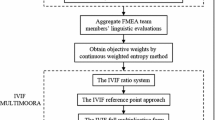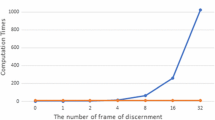Abstract
The traditional failure mode and effects analysis (FMEA) is determined by risk priority number (RPN), which is the product of three risk factors occurrence (O), severity (S), and detection (D). One of the open issues is how to precisely determine and aggregate the risk factors. However, the traditional FMEA has been extensively criticized for various reasons. In this paper, a new method in fuzzy FMEA is proposed using evidential reasoning (ER) and the technique for order preference by similarity to ideal solution (TOPSIS). The ER approach is used to express the experts’ assessment information which may be imprecise and uncertain. Considering the experts’ weights, we construct the group assessment. Weighted average method is then utilized to transform the group assessment value into crisp value. TOPSIS is applied to aggregate the risk factors which are taken to account as the multi-attribute, and used to rank the risk priority. By making full use of attribute information, TOPSIS provides a cardinal ranking of alternatives, and does not require the attribute preferences are independent. A numerical example shows that the proposed method is efficient to its applications.
Similar content being viewed by others
References
Abdelgawad M, Fayek AR (2010) Risk management in the construction industry using combined fuzzy FEMA and fuzzy AHP. J Constr Eng Manag 136(9):1028–1036
Bevilacqua M, Braglia M, Gabbrielli R (2000) Monte Carlo simulation approach for a modified FMECA in a power plant. Qual Reliab Eng Int 16(4):313–324
Bluvband Z, Grabov P (2009) Failure analysis of FMEA. In: Reliability and maintainability symposium 2009, RAMS 2009 annual, pp 344–-347
Braglia M, Frosolini M, Montanari R (2003) Fuzzy TOPSIS approach for failure mode, effects and criticality analysis. Qual Reliab Eng Int 19(5):425–443
Cassanelli G, Mura G, Fantini F, Vanzi M, Plano B (2006) Failure analysis-assisted FMEA. Microelectron Reliab 46(9):1795–1799
Chang KH, Cheng CH (2011) Evaluating the risk of failure using the fuzzy OWA and DEMATEL method. J Intell Manuf 22(2):113–129
Chen LH, Ko WC (2009) Fuzzy linear programming models for new product design using QFD with FMEA. Appl Math Model 33(2):633–647
Chen SJJ, Hwang CL, Beckmann MJ, Krelle W (1992) Fuzzy multiple attribute decision making: methods and applications. Springer, New York
Chin KS, Chan A, Yang JB (2008) Development of a fuzzy FMEA based product design system. Int J Adv Manuf Technol 36(7):633–649
Chin KS, Wang YM, Poon GKK, Yang JB (2009a) Failure mode and effects analysis using a group-based evidential reasoning approach. Comput Oper Res 36(6):1768–1779
Chin KS, Wang YM, Poon GKK, Yang JB (2009b) Failure mode and effects analysis by data envelopment analysis. Decis Support Syst 48(1):246–256
Corbett CJ, Pan JN (2002) Evaluating environmental performance using statistical process control techniques. Eur J Oper Res 139(1):68–83
Fan ZP, Feng B (2009) A multiple attributes decision making method using individual and collaborative attribute data in a fuzzy environment. Inf Sci 179(20):3603–3618
Gao C, Wei D, Hu Y, Mahadevan S, Deng Y (2013) A modified evidential methodology of identifying influential nodes in weighted networks. Physica A 392(21):5490–5500
Garcia PAA, Schirru R, Frutuoso PF (2005) A fuzzy data envelopment analysis approach for FMEA. Prog Nucl Energy 46(3):359–373
Guimarães ACF, Franklin CM (2004) Effects analysis fuzzy inference system in nuclear problems using approximate reasoning. Ann Nucl Energy 31(1):107–115
Guimarães ACF, Lapa CMF, Moreira MDL (2011) Fuzzy methodology applied to probabilistic safety assessment for digital system in nuclear power plants. Nucl Eng Des 241(9):3967–3976
Hwang CL, Yoon KP (1981) Multiple attribute decision making. Springer, New York
Kahraman C, Engin O, Kabak Ö, Kaya İ (2009) Information systems outsourcing decisions using a group decision-making approach. Eng Appl Artif Intell 22(6):832–\841
Kang BY, Deng Y, Sadiq R, Mahadevan S (2012) Evidential cognitive maps. Knowl Syst 35:77–86
Karanki DR, Jadhav PA, Chandrakar A, Srividya A, Verma AK (2010) Uncertainty analysis in PSA with correlated input parameters. Int J Syst Assur Eng Manag 1(1):66–71
Kutlu AC, Ekmekçioğlu M (2012) Fuzzy failure modes and effects analysis by using fuzzy TOPSIS-based fuzzy AHP. Expert Syst Appl 39(1):61–67
Liu HC, Liu L, Liu N, Mao LX (2012a) Risk evaluation in failure mode and effects analysis with extended VIKOR method under fuzzy environment. Expert Syst Appl 39(17):12926–12934
Liu J, Chan FTS, Li Y, Zhang YJ, Deng Y (2012b) A new optimal consensus method with minimum cost in fuzzy group decision. Knowl Syst 35:357–360
Liu HC, Liu L, Liu N (2013a) Risk evaluation approaches in failure mode and effects analysis: a literature review. Expert Syst Appl 40(2):828–838
Liu HC, Liu L, Lin QL (2013b) Fuzzy failure mode and effects analysis using fuzzy evidential reasoning and belief rule-based methodology. IEEE Trans Reliab 62(1):23–36
Narayanagounder S, Gurusami K (2009) A new approach for prioritization of failure modes in design FMEA using ANOVA. Proc World Acad Sci Eng Technol 37:524–531
Sadiq R, Najjaran H, Kleiner Y (2006) Investigating evidential reasoning for the interpretation of microbial water quality in a distribution network. Stoch Environ Res Risk Assess 21(1):63–73
Sadiq R, Kleiner Y, Rajani B (2007) Water quality failures in distribution networks risk analysis using fuzzy logic and evidential reasoning. Risk Anal 27(5):1381–1394
Sharma RK, Sharma P (2010) System failure behavior and maintenance decision making using RCA, FMEA and FM. J Qual Maint Eng 16(1):64–88
Sharma RK, Kumar D, Kumar P (2005) Systematic failure mode effect analysis (FMEA) using fuzzy linguistic modeling. Int J Qual Reliab Manag 22(9):986–1004
Shih HS (2008) Incremental analysis for MCDM with an application to group TOPSIS. Eur J Oper Res 186(2):720–734
Soderholm P, Karim R (2010) An enterprise risk management framework for evaluation of eMaintenance. Int J Syst Assur Eng Manag 1(3):219–228
Su XY, Deng Y, Mahadevan S, Bao QL (2012) An improved method for risk evaluation in failure modes and effects analysis of aircraft engine rotor blades. Eng Fail Anal 26(17):164–174
Tay KM, Lim CP (2006) Fuzzy FMEA with a guided rules reduction system for prioritization of failures. Int J Qual Reliab Manag 23(8):1047–1066
Teng SG, Ho SM (1996) Failure mode and effects analysis: an integrated approach for product design and process control. Int J Qual Reliab Manag 13(5):8–26
Wallnerström CJ, Bertling L, Tuan LA (2010) Risk and reliability assessment for electrical distribution systems and impacts of regulations with examples from Sweden. Int J Syst Assur Eng Manag 1(2):87–95
Wang YM, Yang JB, Xu DL (2006) Environmental impact assessment using the evidential reasoning approach. Eur J Oper Res 174(3):1885–1913
Wang YM, Chin KS, Poon GKK, Yang JB (2009) Risk evaluation in failure mode and effects analysis using fuzzy weighted geometric mean. Expert Syst Appl 36(2):1195–1207
Wei D, Deng X, Zhang X, Deng Y, Mahadevan S (2013) Identifying influential nodes in weighted networks based on evidence theory. Physica A 392(10):2564–2575
Xu K, Tang LC, Xie M, Ho SL, Zhu ML (2002) Fuzzy assessment of FMEA for engine systems. Reliab Eng Syst Saf 75(1):17–29
Yang JB, Xu DL (2002) On the evidential reasoning algorithm for multiple attribute decision analysis under uncertainty. IEEE Trans Syst Man Cybern A 32(3):289–304
Yang JB, Liu J, Wang J, Sii HS, Wang HW (2006a) Belief rule-base inference methodology using the evidential reasoning approach-RIMER. IEEE Trans Syst Man Cybern A 36(2):266–285
Yang JB, Wang YM, Xu DL, Chin KS (2006b) The evidential reasoning approach for MADA under both probabilistic and fuzzy uncertainties. Eur J Oper Res 171(1):309–343
Yang JP, Huang HZ, He LP, Zhu SP, Wen DW (2011) Risk evaluation in failure mode and effects analysis of aircraft turbine rotor blades using Dempster–Shafer evidence theory under uncertainty. Eng Fail Anal 18(8):2084–2092
Yoon KP, Hwang CL (1995) Multiple attribute decision making: an introduction, no. 07-104. Sage, Thousand Oaks
Zafiropoulos EP, Dialynas EN (2005) Reliability prediction and failure mode effects and criticality analysis (FMECA) of electronic devices using fuzzy logic. Int J Qual Reliab Manag 22(2):183–200
Zhang ZF, Chu XN (2011) Risk prioritization in failure mode and effects analysis under uncertainty. Expert Syst Appl 38(1):206–214
Zhang XG, Deng Y, Chan FTS, Xu PD, Mahadevan S, Hu Y (2013a) IFSJSP: a novel methodology for the Job-Shop Scheduling Problem based on intuitionistic fuzzy sets. Int J Prod Res 51(17):5100–5119
Zhang HX, Deng Y, Chan FTS, Zhang XG (2013b) A modified multi-criterion optimization genetic algorithm for order distribution in collaborative supply chain. Appl Math Model 37(14):7855–7864
Acknowledgments
Project supported by Chongqing Natural Science Foundation (for Distinguished Young Scholars), Grant No. CSCT, 2010BA2003, National Natural Science Foundation of China, Grant No. 61174022, National High Technology Research and Development Program of China (863 Program; No. 2013AA013801), Doctor Funding of Southwest University Grant No. SWU110021, National Key Technology R&D Program (2012BAH07B01). We greatly appreciate the editor’s encouragement and the anonymous reviewer’s valuable comments and suggestions to improve this work.
Author information
Authors and Affiliations
Corresponding author
Rights and permissions
About this article
Cite this article
Du, Y., Mo, H., Deng, X. et al. A new method in failure mode and effects analysis based on evidential reasoning. Int J Syst Assur Eng Manag 5, 1–10 (2014). https://doi.org/10.1007/s13198-014-0218-5
Received:
Revised:
Published:
Issue Date:
DOI: https://doi.org/10.1007/s13198-014-0218-5




